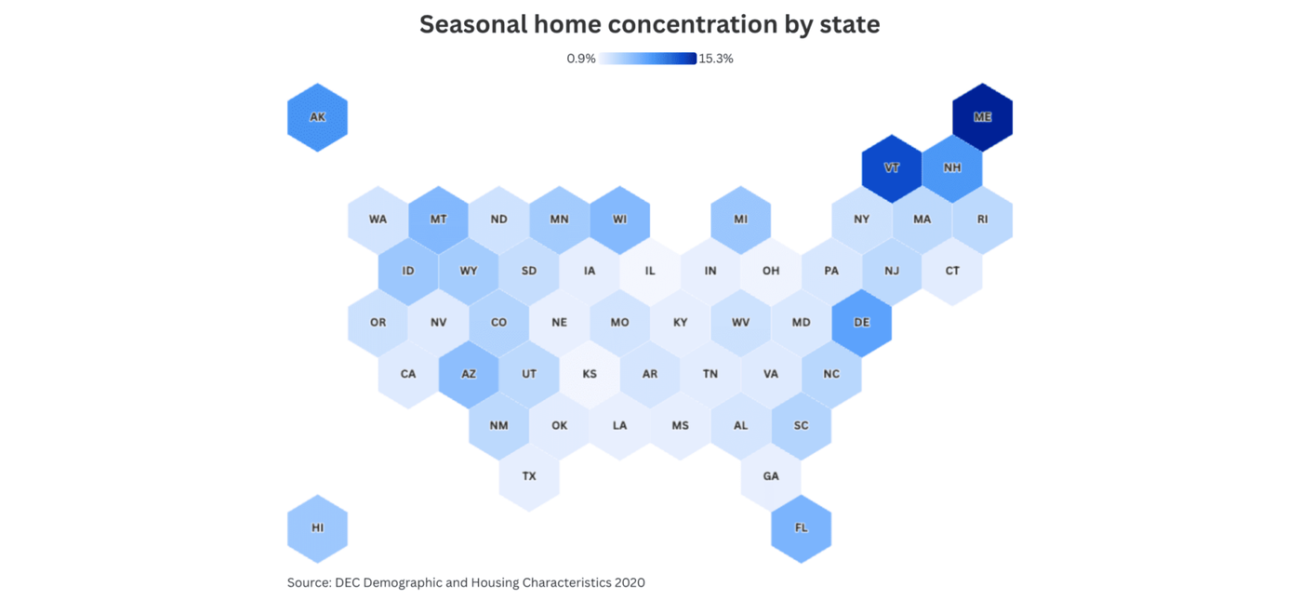Top U.S. counties with the most seasonal housing are popular for vacation homes.
Owning a second home in a favorite vacation spot is a symbol of success for many Americans, from ski retreats in Colorado to...
August 2nd 2025.

For many Americans, owning a second home in their favorite vacation spot is more than just a dream - it's a symbol of success. From cozy ski retreats in Colorado to charming summer cottages on Cape Cod, these seasonal homes are becoming increasingly popular and are changing the landscape of the housing market in many counties across the country. And with experts projecting a decline in mortgage rates by 2025, the opportunity to purchase a piece of paradise may soon become a reality for more people.
According to a recent analysis by the U.S. Census Bureau, there are currently over 4.3 million homes classified as "vacant seasonal," making it the largest category of vacant housing in the nation. Using this data, as well as housing price information from the National Association of Realtors, Wealth Enhancement has mapped out where vacation homes make up the highest percentage of housing and examined the economic impact in these areas.
It's clear that seasonal homes are not just a niche market - they are a major component of the nation's vacant housing inventory. These homes are primarily concentrated in coastal and mountain regions, where the natural beauty, recreational opportunities, and rental demand create the perfect environment for a second home.
In fact, in 645 out of 3,143 U.S. counties, seasonal homes make up at least 50% of all vacant units. The state with the highest percentage of seasonal homes is Maine, followed by Vermont and Alaska. Nationally, there are currently 6.5 million second homes, making up 4.6% of all homes. Florida stands out as a leader in this market, with over 1 million second homes, which accounts for over 15% of the national total.
Let's take a closer look at some of the top vacation home counties, where the demand for seasonal homes is the strongest. These destinations attract second-home owners with their picturesque landscapes, thriving rental markets, and well-established vacation economies.
In Lee County, Florida, there are 69,007 seasonal homes, making up 17% of the total housing. The median price for a seasonal home in this area is $247,000. In Barnstable County, Massachusetts, there are 54,267 seasonal homes, accounting for 33% of the total housing. The median price for a seasonal home here is $475,000. Collier County, Florida, has 57,494 seasonal homes, which make up 25% of the total housing, with a median price of $314,000. And in Dukes County, Massachusetts, there are 7,747 seasonal homes, making up a whopping 44% of the total housing. The median price for a seasonal home in this county is $1,400,000.
These numbers are based on 2020 Census data and housing price data from the National Association of Realtors.
Other popular destinations for seasonal homes include Colorado's ski counties and Michigan's lakefront areas, as well as parts of the Pacific Northwest. In these areas, second homes can make up a significant portion of the housing market, especially in smaller counties where the seasonal population shifts are more noticeable.
The demand for seasonal homes has a unique impact on local real estate markets. Unlike primary residences, the prices of vacation homes can fluctuate significantly depending on the time of year, with seasonal trends driving 5% to 10% swings in home prices, according to Investopedia. Additionally, the presence of seasonal homes can limit the inventory available for full-time residents.
Local economies often rely on these properties for tourism revenue and job opportunities. For example, in Cape Cod, second homes make up 37% of the housing stock. Since 2021, the number of rental property owners in this area has increased by 48%, according to Boston 25 News. In Aspen, Colorado, the economy is thriving year-round thanks to its status as a popular resort and cultural destination, creating a demand for home maintenance, rental management, and hospitality services.
The projected decline in interest rates could make vacation homeownership more accessible for many people. According to Morgan Stanley, the current 30-year mortgage rate of 6.77% could fall to as low as 6.25% by late 2025. This decrease in rates could make a significant difference for buyers looking to invest in a second property, with a potential savings of $400 per month on a $1 million mortgage.
Interest rate changes have a unique impact on the vacation home market, as these purchases are often discretionary and require larger down payments. If rates continue to decline, many high-income buyers may see 2025 as the perfect time to purchase their dream vacation home.
So, what draws buyers to these prime vacation destinations? The appeal goes beyond just aesthetics. These places tend to offer scenic amenities like beaches, mountains, or lakes, as well as high rental income potential during peak seasons. They are also often close to urban areas, making them ideal for weekend getaways. Additionally, these areas typically have strong resale value and long-term price appreciation, as well as established infrastructure to support tourism and seasonal living.
Whether it's for investment, lifestyle, or legacy, owning a second home is a powerful aspiration and a significant factor in the real estate market. With over 6 million second homes already in circulation and interest rates expected to decline in 2025, the desire for vacation properties is only expected to grow. For potential buyers, knowing where these homes are concentrated and how they impact local economies can help identify the best opportunities for long-term value and enjoyment.
In conclusion, seasonal homes are transforming the real estate market across the U.S. With the possibility of more people being able to afford a second home and the appeal of these destinations only getting stronger, the demand for vacation properties is expected to continue to rise. This story was produced by Wealth Enhancement and reviewed and distributed by Stacker.
According to a recent analysis by the U.S. Census Bureau, there are currently over 4.3 million homes classified as "vacant seasonal," making it the largest category of vacant housing in the nation. Using this data, as well as housing price information from the National Association of Realtors, Wealth Enhancement has mapped out where vacation homes make up the highest percentage of housing and examined the economic impact in these areas.
It's clear that seasonal homes are not just a niche market - they are a major component of the nation's vacant housing inventory. These homes are primarily concentrated in coastal and mountain regions, where the natural beauty, recreational opportunities, and rental demand create the perfect environment for a second home.
In fact, in 645 out of 3,143 U.S. counties, seasonal homes make up at least 50% of all vacant units. The state with the highest percentage of seasonal homes is Maine, followed by Vermont and Alaska. Nationally, there are currently 6.5 million second homes, making up 4.6% of all homes. Florida stands out as a leader in this market, with over 1 million second homes, which accounts for over 15% of the national total.
Let's take a closer look at some of the top vacation home counties, where the demand for seasonal homes is the strongest. These destinations attract second-home owners with their picturesque landscapes, thriving rental markets, and well-established vacation economies.
In Lee County, Florida, there are 69,007 seasonal homes, making up 17% of the total housing. The median price for a seasonal home in this area is $247,000. In Barnstable County, Massachusetts, there are 54,267 seasonal homes, accounting for 33% of the total housing. The median price for a seasonal home here is $475,000. Collier County, Florida, has 57,494 seasonal homes, which make up 25% of the total housing, with a median price of $314,000. And in Dukes County, Massachusetts, there are 7,747 seasonal homes, making up a whopping 44% of the total housing. The median price for a seasonal home in this county is $1,400,000.
These numbers are based on 2020 Census data and housing price data from the National Association of Realtors.
Other popular destinations for seasonal homes include Colorado's ski counties and Michigan's lakefront areas, as well as parts of the Pacific Northwest. In these areas, second homes can make up a significant portion of the housing market, especially in smaller counties where the seasonal population shifts are more noticeable.
The demand for seasonal homes has a unique impact on local real estate markets. Unlike primary residences, the prices of vacation homes can fluctuate significantly depending on the time of year, with seasonal trends driving 5% to 10% swings in home prices, according to Investopedia. Additionally, the presence of seasonal homes can limit the inventory available for full-time residents.
Local economies often rely on these properties for tourism revenue and job opportunities. For example, in Cape Cod, second homes make up 37% of the housing stock. Since 2021, the number of rental property owners in this area has increased by 48%, according to Boston 25 News. In Aspen, Colorado, the economy is thriving year-round thanks to its status as a popular resort and cultural destination, creating a demand for home maintenance, rental management, and hospitality services.
The projected decline in interest rates could make vacation homeownership more accessible for many people. According to Morgan Stanley, the current 30-year mortgage rate of 6.77% could fall to as low as 6.25% by late 2025. This decrease in rates could make a significant difference for buyers looking to invest in a second property, with a potential savings of $400 per month on a $1 million mortgage.
Interest rate changes have a unique impact on the vacation home market, as these purchases are often discretionary and require larger down payments. If rates continue to decline, many high-income buyers may see 2025 as the perfect time to purchase their dream vacation home.
So, what draws buyers to these prime vacation destinations? The appeal goes beyond just aesthetics. These places tend to offer scenic amenities like beaches, mountains, or lakes, as well as high rental income potential during peak seasons. They are also often close to urban areas, making them ideal for weekend getaways. Additionally, these areas typically have strong resale value and long-term price appreciation, as well as established infrastructure to support tourism and seasonal living.
Whether it's for investment, lifestyle, or legacy, owning a second home is a powerful aspiration and a significant factor in the real estate market. With over 6 million second homes already in circulation and interest rates expected to decline in 2025, the desire for vacation properties is only expected to grow. For potential buyers, knowing where these homes are concentrated and how they impact local economies can help identify the best opportunities for long-term value and enjoyment.
In conclusion, seasonal homes are transforming the real estate market across the U.S. With the possibility of more people being able to afford a second home and the appeal of these destinations only getting stronger, the demand for vacation properties is expected to continue to rise. This story was produced by Wealth Enhancement and reviewed and distributed by Stacker.
[This article has been trending online recently and has been generated with AI. Your feed is customized.]
[Generative AI is experimental.]
0
0
Submit Comment





